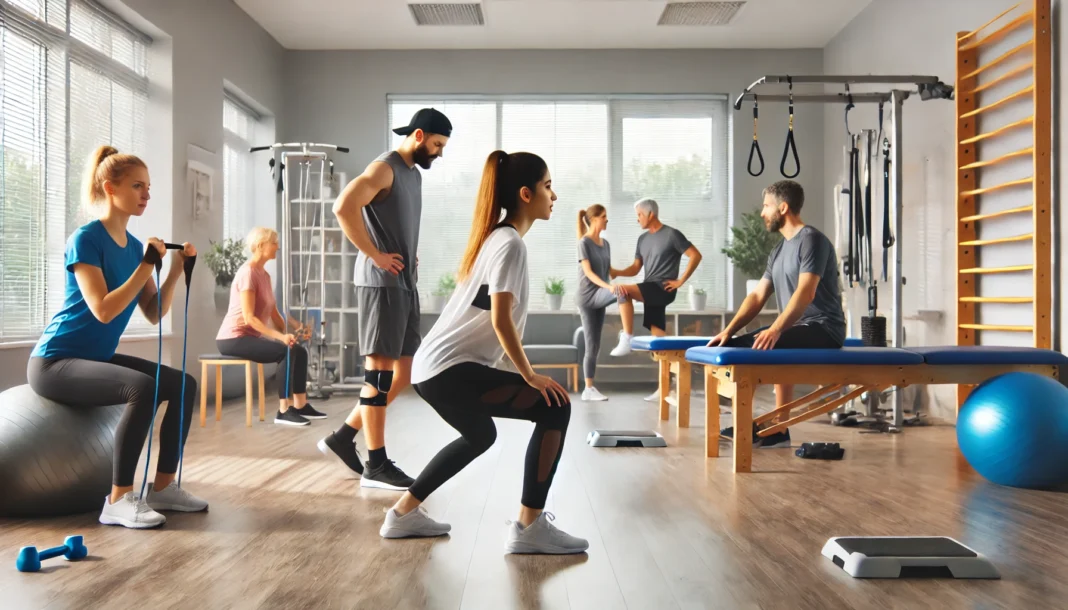Understanding Functional Movement: The Foundation of Daily Motion
Functional movement is an essential yet often overlooked aspect of physical health. At its core, functional movement refers to the ability to perform natural, everyday motions efficiently and without discomfort. Unlike isolated strength training, which targets individual muscle groups, functional movement focuses on the body’s ability to work as a cohesive unit, enhancing coordination, balance, and resilience. From standing up from a chair to reaching for an object on a high shelf, these motions rely on the intricate interplay of muscles, joints, and neuromuscular control.
In modern society, sedentary lifestyles and repetitive movement patterns have led to a decline in overall functional mobility. Many people unknowingly develop compensatory movement habits that, over time, contribute to muscle imbalances, joint stiffness, and increased injury risk. Functional movement therapy addresses these issues by assessing movement quality, identifying dysfunctions, and implementing corrective exercises. This proactive approach helps restore optimal movement patterns and ensures longevity in both daily activities and athletic performance.
Functional movement is not limited to elite athletes or fitness enthusiasts. It is a critical component of overall well-being for people of all ages and activity levels. Whether one is lifting groceries, playing with children, or engaging in recreational sports, functional mobility plays a pivotal role in injury prevention and efficiency of movement. Developing an awareness of functional movement mechanics can lead to a more active, pain-free lifestyle while reducing the likelihood of chronic conditions such as lower back pain, joint degeneration, and muscular fatigue.
You May Also Like: Functional Fitness Definition: How It Enhances Strength, Mobility, and Daily Life
The Biomechanics of Functional Movement
At its essence, functional movement is guided by principles of biomechanics—the study of how the body moves. Every motion, from walking to bending, relies on complex interactions between muscles, joints, tendons, and the nervous system. Functional movement requires proper joint mobility, muscular strength, stability, and motor control to execute movements safely and effectively. Deficiencies in any of these areas can lead to compensatory patterns, increasing the risk of strain and injury.
A fundamental aspect of functional movement is the kinetic chain concept, which describes how different parts of the body work together to produce motion. The human body is a series of interconnected segments, and when one part moves, it influences the movement of adjacent structures. For instance, inefficient hip mobility can lead to excessive strain on the lower back, while poor ankle flexibility may alter walking mechanics and contribute to knee pain. Understanding how these chains interact can help individuals pinpoint and correct movement deficiencies before they escalate into chronic pain or dysfunction.
Proprioception—the body’s ability to sense its position in space—is another critical factor in functional movement. The nervous system continuously gathers information from muscles and joints, allowing for precise movement control. When proprioception is impaired due to injury, lack of use, or poor movement habits, coordination suffers, and compensatory patterns develop. Functional movement training integrates exercises that enhance proprioception, ensuring smoother and more efficient motion in everyday activities.

Common Movement Dysfunctions and Their Consequences
Many individuals unknowingly develop movement dysfunctions due to poor posture, sedentary habits, or unbalanced training regimens. These dysfunctions often manifest in subtle ways at first, such as occasional stiffness or discomfort, but can gradually progress to chronic pain, reduced mobility, and injury. Recognizing these dysfunctions early is crucial in preventing long-term damage to joints and muscles.
One of the most prevalent movement dysfunctions is limited hip mobility. Tight hip flexors, often resulting from prolonged sitting, restrict natural movement patterns and force the lower back to compensate. This compensation leads to increased stress on the lumbar spine, often causing chronic lower back pain. Addressing this dysfunction requires targeted stretching and strengthening exercises that restore proper hip function and alleviate excessive spinal load.
Poor scapular control is another common issue, particularly in individuals who spend extended hours working at desks or using electronic devices. Rounded shoulders and forward head posture contribute to scapular instability, reducing shoulder mobility and increasing the risk of rotator cuff injuries. Functional movement therapy emphasizes corrective exercises that strengthen the upper back and improve postural alignment, mitigating these risks.
Knee instability is yet another prevalent dysfunction, often linked to weak gluteal muscles or improper foot mechanics. When the muscles responsible for stabilizing the knee joint are weak or imbalanced, excessive stress is placed on the ligaments and cartilage. This instability can result in conditions such as patellar tracking disorder or meniscus injuries. Strengthening the surrounding musculature and improving movement mechanics can significantly reduce knee-related issues.
Functional Movement Therapy: Restoring Mobility and Strength
Functional movement therapy is a structured approach designed to assess, correct, and enhance movement efficiency. Unlike conventional physical therapy, which often focuses on isolated injuries, functional movement therapy takes a holistic view of the body’s interconnected systems. By evaluating an individual’s movement patterns, therapists can identify weaknesses, compensations, and inefficiencies that contribute to pain or dysfunction.
A key component of functional movement therapy is movement screening, which involves assessing an individual’s ability to perform fundamental motions such as squatting, lunging, and bending. These screenings help determine which areas of the body require mobility work, strengthening, or neuromuscular retraining. Once deficiencies are identified, therapists create personalized exercise programs that target specific weaknesses while promoting overall movement efficiency.
Restoring proper movement requires a combination of mobility exercises, stability training, and strength development. Mobility work focuses on improving joint flexibility and range of motion, ensuring that movement is unrestricted and fluid. Stability exercises enhance core and joint control, preventing unnecessary stress on vulnerable areas such as the lower back or knees. Strength development reinforces proper movement mechanics, allowing the body to handle everyday tasks with ease and reduced injury risk.

The Role of Functional Movement in Injury Prevention
One of the primary benefits of functional movement training is its ability to prevent injuries before they occur. Many injuries, particularly those related to overuse or poor biomechanics, develop gradually over time. Addressing underlying movement deficiencies before they lead to pain or dysfunction is a proactive approach to long-term health and mobility.
Functional movement training enhances the body’s resilience by improving muscular balance, joint stability, and neuromuscular coordination. For instance, individuals who perform repetitive motions in their daily lives—such as lifting, bending, or prolonged standing—benefit from strengthening the muscles that support these movements. Strengthening the posterior chain (hamstrings, glutes, and lower back) can reduce strain on the lumbar spine, decreasing the likelihood of lower back injuries.
Additionally, functional movement training reduces the risk of falls and balance-related injuries, particularly in older adults. By incorporating exercises that improve proprioception and core stability, individuals enhance their ability to react quickly to environmental changes, such as uneven surfaces or unexpected shifts in body weight. This adaptability is crucial in maintaining independence and preventing age-related mobility decline.
Incorporating Functional Movement into Daily Life
Integrating functional movement principles into daily activities does not require extensive gym sessions or specialized equipment. Simple adjustments in posture, movement mechanics, and daily routines can significantly improve overall mobility and injury resistance. Awareness is the first step—recognizing how one moves throughout the day and identifying areas where posture or mechanics can be improved.
For example, practicing proper lifting techniques—such as engaging the core, keeping the spine neutral, and using the legs rather than the back—can prevent strain on the lower back and reduce the risk of injury. Similarly, incorporating dynamic stretching and mobility drills into a daily routine enhances flexibility and prepares the body for movement, reducing stiffness and discomfort.
Another effective strategy is to break up prolonged periods of inactivity with movement breaks. Sitting for extended periods can lead to joint stiffness and muscle tightness, particularly in the hips and lower back. Standing up, stretching, or walking for a few minutes every hour promotes circulation and prevents movement dysfunctions from developing.

Frequently Asked Questions (FAQ) on Functional Movement
1. What is functional movement, and how does it impact long-term physical health?
Functional movement refers to the body’s ability to perform natural, everyday motions efficiently and without discomfort. Over time, incorporating functional movement into daily life reduces the likelihood of developing chronic conditions such as arthritis, postural misalignment, and muscular imbalances. By improving movement patterns early on, individuals can prevent the cumulative wear and tear that leads to mobility issues in later years. Functional movement therapy plays a crucial role in addressing early signs of dysfunction before they escalate into severe health concerns. Focusing on movement efficiency enhances longevity, allowing individuals to maintain independence and physical capability as they age.
2. How does functional movement therapy benefit mental well-being?
While functional movement therapy primarily focuses on improving physical mobility, it also has profound effects on mental well-being. Engaging in movement-based therapy can enhance cognitive function by stimulating neural pathways involved in coordination and balance. Additionally, the reduction of physical discomfort through improved movement efficiency leads to lower stress levels, improved mood, and increased confidence in daily activities. Functional movement also encourages mindfulness, as individuals become more aware of their body’s positioning and mechanics. This heightened awareness fosters a positive relationship between mental and physical health, promoting overall resilience and well-being.
3. Can functional movement therapy help with financial savings on healthcare costs?
Yes, functional movement therapy can contribute to significant healthcare savings by preventing injuries and chronic conditions that lead to costly medical treatments. By improving movement patterns and reducing strain on joints and muscles, individuals decrease their risk of requiring physical therapy, orthopedic interventions, or pain management treatments. Employers are increasingly recognizing the benefits of functional movement therapy in workplace ergonomics, reducing workers’ compensation claims and healthcare expenses. Preventive care through movement training ensures fewer doctor visits related to musculoskeletal disorders. Long-term financial planning should include investments in movement-based wellness programs, as they offer both health and economic benefits.
4. How does functional movement relate to the biomechanics of high-performance athletes?
For high-performance athletes, functional movement is essential in optimizing strength, agility, and injury resistance. Unlike traditional weightlifting, which isolates muscle groups, functional movement training enhances multi-joint coordination, ensuring that the body moves as an integrated system. Functional movement therapy identifies biomechanical inefficiencies that could hinder athletic performance and lead to injuries under high-stress conditions. Many professional sports teams incorporate movement screenings and corrective exercises into their training programs to enhance efficiency and longevity. Understanding the functional movement definition in the context of elite sports highlights its importance in maximizing physical potential and career sustainability.
5. How can functional movement training be incorporated into a busy lifestyle?
Even with a demanding schedule, individuals can integrate functional movement into their daily routines without extensive workouts. Simple habits, such as maintaining proper posture while sitting, engaging the core when lifting objects, and incorporating dynamic stretching throughout the day, promote better movement efficiency. Functional movement therapy exercises, such as balance drills or bodyweight squats, can be performed in short bursts, making them accessible even during work breaks. Additionally, incorporating activities such as walking meetings, ergonomic work setups, and mobility-based warm-ups before workouts ensures continuous functional movement practice. A proactive approach to movement minimizes physical strain and enhances long-term mobility without requiring drastic lifestyle changes.
6. What role does technology play in functional movement therapy?
Advancements in technology have transformed how functional movement therapy is assessed and implemented. Wearable devices and motion-tracking software can analyze movement patterns in real time, identifying inefficiencies that might not be visible to the naked eye. Virtual reality (VR) and artificial intelligence (AI)-driven coaching provide interactive movement correction, allowing individuals to practice functional exercises with instant feedback. Additionally, telehealth services now offer virtual functional movement assessments, making therapy more accessible to individuals who may not have access to in-person sessions. As technology continues to evolve, functional movement therapy will become even more personalized and data-driven, enhancing movement optimization strategies.
7. Can functional movement prevent workplace-related musculoskeletal issues?
Yes, functional movement training plays a significant role in preventing work-related musculoskeletal issues, particularly for individuals in sedentary or physically demanding jobs. Poor ergonomic setups, repetitive motions, and prolonged sitting can contribute to chronic pain and movement dysfunctions. Functional movement therapy provides targeted interventions, such as mobility drills and posture correction techniques, to mitigate workplace strain. Employers who integrate movement education into wellness programs often see reductions in absenteeism and injury-related downtime. Investing in functional movement training for employees can improve productivity while fostering a healthier work environment.
8. How does functional movement training adapt for older adults?
Functional movement training is highly adaptable and beneficial for older adults, focusing on balance, joint mobility, and fall prevention. As individuals age, proprioception and coordination naturally decline, increasing the risk of injuries from simple movements like stepping off a curb or reaching overhead. Functional movement therapy incorporates exercises that strengthen stabilizing muscles and enhance reaction time, helping older adults maintain independence. Low-impact activities such as chair-assisted squats, resistance band exercises, and controlled stretching improve mobility without placing excessive stress on the joints. By prioritizing functional movement, older adults can maintain an active lifestyle and reduce their risk of mobility-related limitations.
9. What are the economic trends driving the demand for functional movement therapy?
The rising demand for functional movement therapy is fueled by increased awareness of preventive healthcare and the economic burden of musculoskeletal disorders. As healthcare costs continue to escalate, individuals and businesses are seeking cost-effective solutions to reduce long-term medical expenses. The fitness industry has also seen a shift toward movement-based training programs, with gyms and rehabilitation centers incorporating functional training spaces. Additionally, insurance companies are beginning to recognize the value of movement therapy, leading to potential coverage for preventive care programs. This growing trend highlights the financial and practical benefits of adopting functional movement as a standard component of wellness initiatives.
10. What is the future of functional movement therapy in sports science and rehabilitation?
The future of functional movement therapy in sports science and rehabilitation is expected to integrate cutting-edge research, technology, and biomechanical analysis. Emerging fields such as neuroplasticity training and sensor-based motion tracking will allow for more precise rehabilitation strategies tailored to individual movement patterns. Functional movement therapy will also become more specialized, with protocols designed for specific populations, such as military personnel, first responders, and individuals with neurological disorders. Additionally, the fusion of functional movement training with virtual reality will provide immersive rehabilitation experiences that accelerate recovery. As research continues to validate its effectiveness, functional movement therapy will remain a cornerstone of injury prevention and performance enhancement in various fields.
Conclusion: Prioritizing Functional Movement for Lifelong Mobility
Functional movement is the foundation of healthy, pain-free motion, influencing everything from daily activities to athletic performance. By understanding its significance, individuals can take proactive steps to improve mobility, prevent injuries, and enhance overall well-being. Functional movement therapy provides an effective approach to identifying and correcting movement inefficiencies, ensuring that the body operates as a cohesive unit.
Incorporating functional movement principles into everyday life fosters long-term mobility and resilience. Whether through structured exercises, postural awareness, or simple adjustments in movement habits, prioritizing functional movement leads to greater ease, efficiency, and longevity in daily activities. Embracing this approach not only prevents injuries but also enhances quality of life, allowing individuals to move with confidence and freedom at any stage of life.
functional movement, injury prevention, daily mobility, movement therapy, biomechanics, healthy lifestyle, functional fitness, movement efficiency, mobility training, joint health, posture correction, core stability, physical wellness, movement assessment, muscle balance
Further Reading:
Efficacy of the functional movement screen: a review

